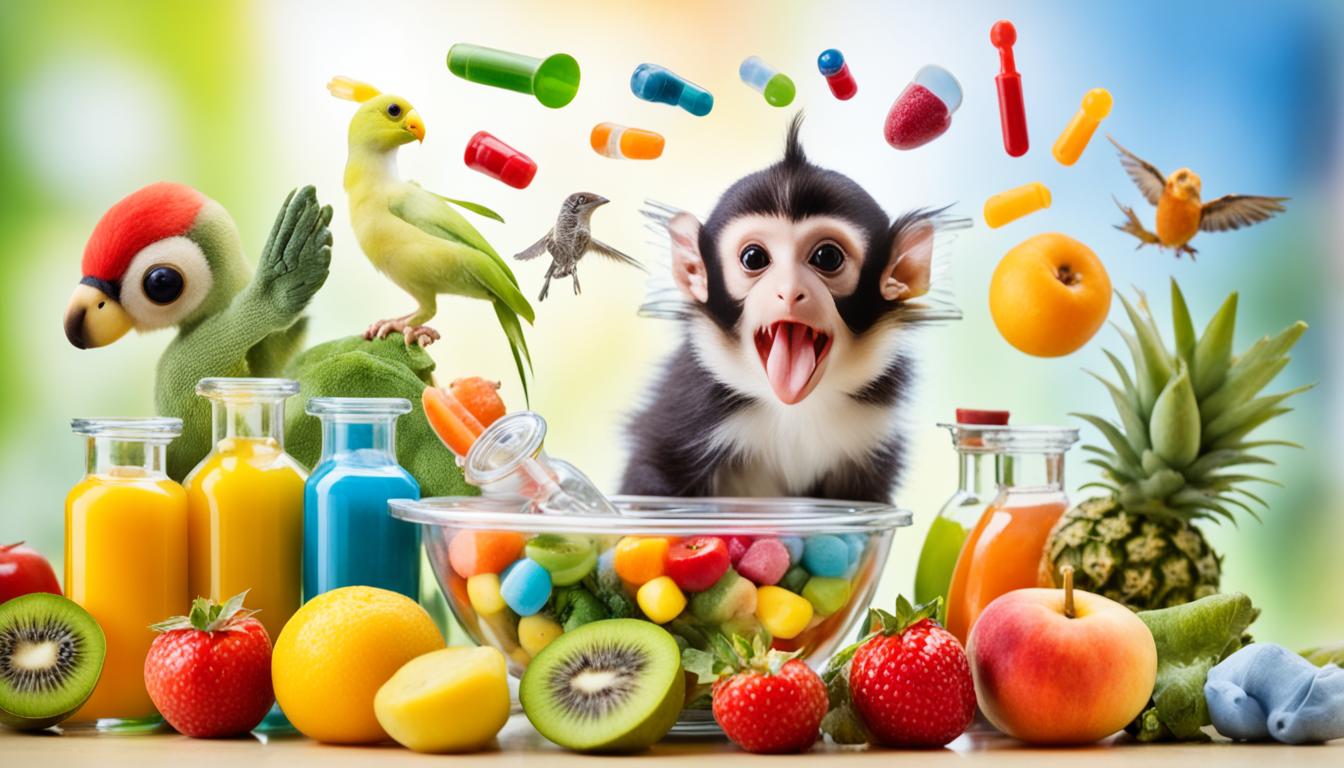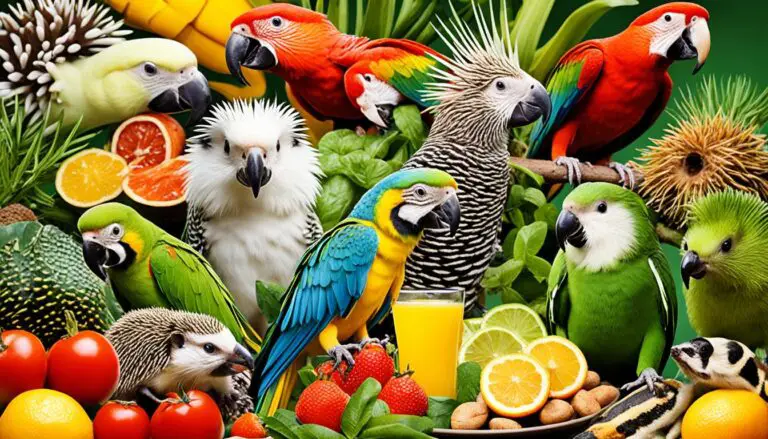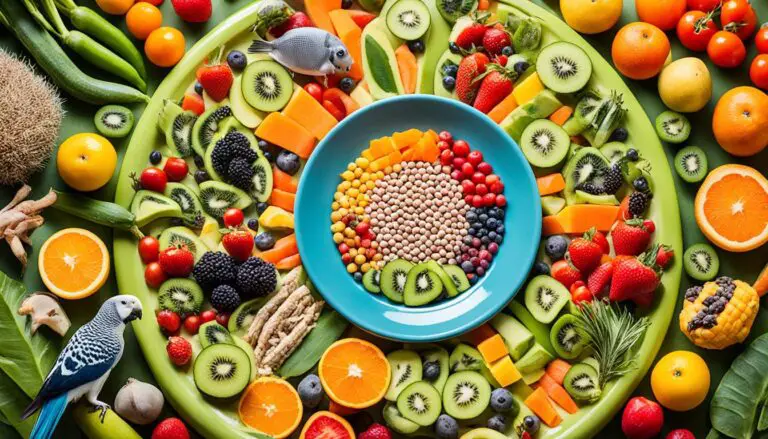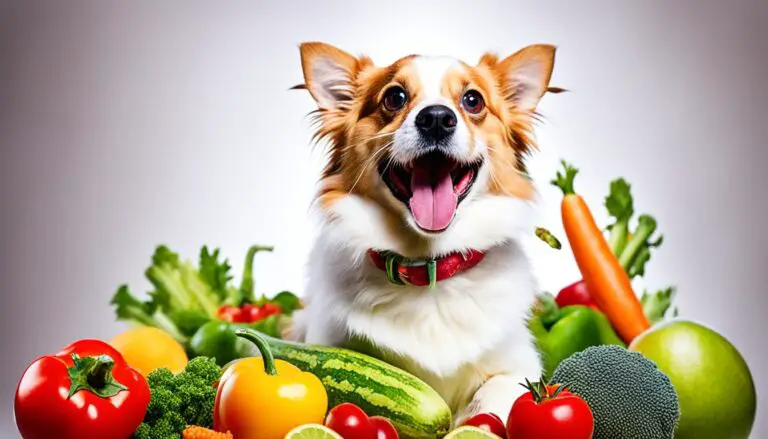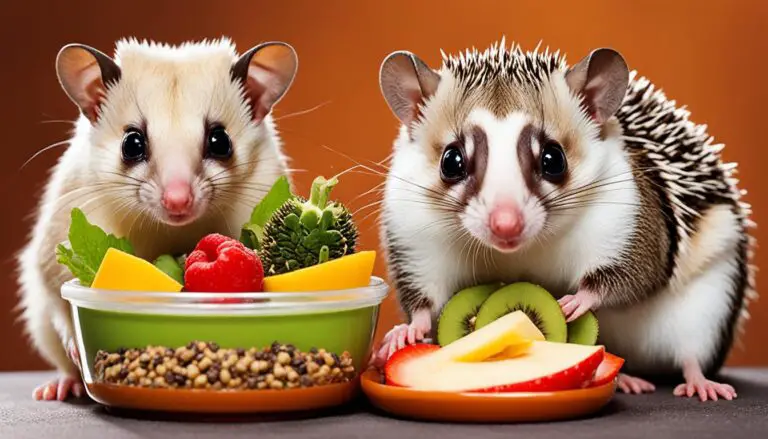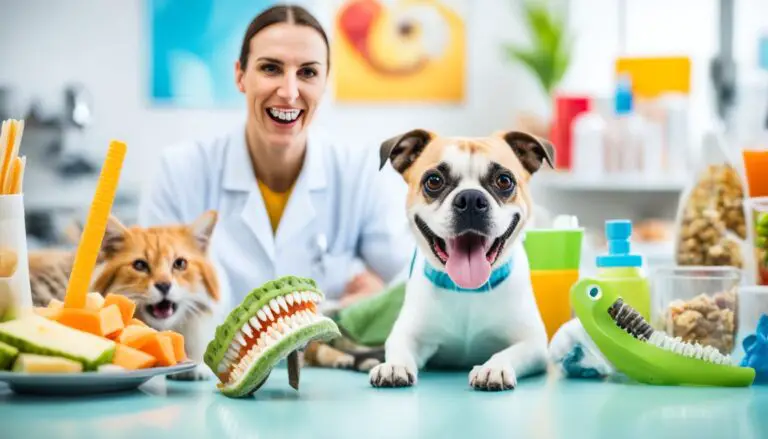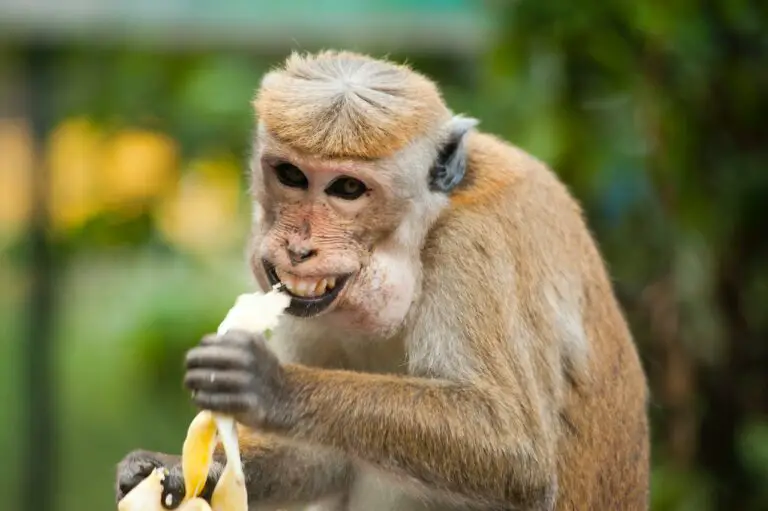Hand-Feeding Diets for Baby Exotic Animals
Hand-feeding and weaning diets are key for baby exotic animals’ growth. Good nutrition matters a lot for their well-being. So, it’s vital for exotic pet owners to grasp their pets’ special nutritional needs.
Exotic animals need exceptional care, which includes the right hand-feeding. This diet must offer what they need to grow strong. By feeding them correctly, selecting the proper diet, and shifting them to solid foods slowly, owners can help their pets do well.
Key Takeaways:
- Hand-feeding and weaning diets are crucial for the healthy development of baby exotic animals.
- Proper nutrition is essential in ensuring their growth and well-being.
- Exotic animal owners should understand the unique dietary needs of their pets.
- Choosing the right hand-feeding diet is crucial for the health and well-being of baby exotic animals.
- Hand-feeding allows for close monitoring of the pet’s intake and ensures a balanced diet.
The Importance of Hand-Feeding
Hand-feeding is vital when caring for baby exotic animals. It ensures they get the nutrients for healthy growth. Owners can watch their pets’ diet carefully, making sure it’s balanced. This is key during their early life stages.
It’s especially crucial as they start eating solid food. It helps babies move from milk to solids smoothly. This way, they learn the eating skills they need to feed themselves later.
“Hand-feeding lets us keep an eye on what baby exotics eat, adjusting as needed,” says Dr. Sarah Thompson. She’s a top vet in exotics. “It’s essential for their growth and well-being.”
By hand-feeding, owners do more than just feed their pets. They build a strong bond and trust. This is great for both the pets and their owners, creating a happy home for the animals.
Benefits of Hand-Feeding:
- Provides essential nutrition for proper growth and development
- Allows for close monitoring of the pet’s intake
- Facilitates a smooth weaning process
- Strengthens the bond between owner and pet
Choosing to hand-feed is choosing a close relationship with your exotic pet. It gives them the best start in life, ensuring they’re healthy and happy.

Choosing the Right Hand-Feeding Diet
Raising baby exotic animals means picking the right diet is key. Each of these animals has unique food needs. It’s vital to meet these needs for their health. A good diet has proteins, carbs, fats, and vitamins to help the babies grow well.
It’s important to look at what these animals eat in the wild. Talk to experts about what to feed them. The goal is to make a diet that’s just like what they would find naturally.
Feeding baby exotics the right diet is about more than the food itself. The time and amount you feed them matter too. A good schedule helps their bodies work right.
It prevents them from eating too much or too little, both of which can cause problems. Here is a feeding guide to help:
| Age | Feeding Frequency | Feeding Amount |
|---|---|---|
| 0-2 weeks | Every 2 hours | 2-4% of body weight |
| 2-4 weeks | Every 3 hours | 3-7% of body weight |
| 4-6 weeks | Every 4 hours | 5-8% of body weight |
| 6-8 weeks | Every 6 hours | 7-10% of body weight |
Remember, these are general guidelines. Every animal is different. You should always check with a vet or a nutrition expert. They can help you tailor a feeding plan just for your little exotic.
Image Here:

“Choosing the right hand-feeding diet is crucial for the health and well-being of baby exotic animals. These diets should be formulated specifically to meet the nutritional needs of each species.”
Start your baby exotics off right with a balanced diet. This is crucial for their early growth. It aims to help them become healthy and vibrant pets.
Hand-Feeding Technique and Equipment
The way you hand-feed baby exotic animals really matters. Using the right technique and tools is key for their happiness and growth.
Feeding Devices: Feeding devices like syringes or eye droppers are best. They give you control over how much formula the animal gets. This way, they get the nutrition they need to do well.
Formula Preparation: Always prepare the formula as the maker says. It ensures the mix has all the right nutrients for the animal’s development.
Serving Temperature: Formula temperature is important for the animal’s comfort. The right temp varies by type, so ask a vet for the correct info.
Monitoring Crop Fullness: A baby animal has a special place to store food. When feeding, check how full this area is. This helps you know if they need more or less food, avoiding tummy issues.

Remember: Using the right tools and methods is very important. It ensures baby exotic animals get the best care. With expert advice and following these steps, your pet will grow well and be healthy.
Monitoring the Baby’s Growth and Progress
During the hand-feeding and weaning of baby exotic animals, close monitoring is key. This ensures they grow well and adapt to changing diets. Keeping a close check helps exotic pet owners make sure their animals are healthy.
Weight gain is a top factor to watch for. Regular weigh-ins tell us if the feeding plan is working. If they are gaining weight, it shows they are getting the right nutrition for growth.
Also, look out for how their behavior changes. This helps tell if they are ready for solid food. They might show more interest in their surroundings and food. This change means they are getting ready to eat more solid things.
Watching their feathers or fur grow is another way to check progress. In birds, more feathers means they are getting older. For mammals, it’s about their fur. Their changing looks give hints about how they are growing.
As they grow, their diet needs to change too. Moving them to solid food should happen slowly. It helps prevent issues. Getting advice from a vet or an expert is a smart move in this weaning process.

Monitoring the Baby’s Growth and Progress
| Indicators | Significance |
|---|---|
| Weight gain | Ensures adequate nutrition and healthy growth |
| Behavior changes | Indicates readiness for solid foods and independence |
| Development of feathers or fur | Shows progress towards adulthood and healthy development |
Introducing Solid Foods and Weaning
As baby exotic animals grow, they must start eating solid foods. This process is called weaning. It’s important to do this slowly, giving them many types of foods. We should watch to see how they like the food and if it goes well with their stomachs.
By weaning, these animals learn to eat independently, preparing them for their adult diet.
For baby exotic animals, moving to solid foods is crucial. It helps them become more independent, and they get what they need to grow. We introduce solid foods slowly. This is to let them learn to like different tastes and textures.
“Introducing solid foods to baby exotic animals can be a rewarding experience for both the animal and the owner. It is important to offer a variety of appropriate foods to encourage a well-balanced diet and ensure the animal’s health and development,” says Dr. Emma Johnson, a renowned exotic animal veterinarian.
Exotic animal owners must pick their weaning foods wisely. They need to consider what their specific kinds of animals need to eat. A mix of many different foods is key. It gives the animals all the nutrients they require.
This guide is useful for transitioning baby exotic animals to solid foods:
1. Begin with Blended Mixtures
Blend the formula they are used to with a bit of mashed fruits, veggies, or quality pelletized foods. Then, up the amount of solid food you mix in. This helps the animal get used to new flavors and textures.
2. Offer a Variety of Foods
Give a mix of fruits, veggies, and proteins suitable for your animal. Variety makes sure they get all they need. It also helps them learn to eat different foods.
3. Monitor Acceptance and Digestion
Watch how your animal reacts to the new foods. Look for any problems like not liking the food, trouble chewing, or stomach issues. If you see any problems, talk to a vet.
4. Establish a Feeding Schedule
Set a feeding schedule that fits your animal’s age and what they eat in the wild. Start with small, frequent meals. Then, as they get better at eating, you can give meals less often.
5. Consult with an Exotic Animal Expert
It’s smart to get advice from someone who knows a lot about exotic animals. They can offer help with what to feed and how to do it right. They can also answer any questions you have.
| Benefits of Introducing Solid Foods and Weaning | Challenges of Introducing Solid Foods and Weaning |
|---|---|
|
|
Every baby exotic animal is different. Weaning timelines may vary. It’s important to be patient and watch how they do. With a good diet and patience, they will grow healthy and strong.
Common Challenges in Hand-Feeding and Weaning
Hand-feeding and weaning baby exotic animals pose unique challenges. Each animal is different. They might have their own ways to tackle solid foods. Also, moving from hand-feeding to eating on their own can be quite the journey. Challenges include:
- Some exotic animals might not want to try new foods. They could be picky about textures. This can make introducing solid foods tough. Being patient and trying different approaches is important.
- Exotic animals could get tummy issues while weaning. This includes problems like diarrhea or constipation. Such issues can be due to diet changes or how they’re fed. A vet’s advice is crucial to handle these issues and keep the animal healthy.
- Getting baby exotics to stop hand-feeding is not always easy. It can take time and be a bit hard. They might not like the new routine and stress over it. Watching them closely and adjusting their diet can smooth out the process.
When you’re stuck with these weaning issues, a vet or an exotic animal expert can help a lot. They offer support and tips to wean your baby exotic pet successfully and keep them healthy.
Knowing and dealing with weaning issues helps exotic animal owners care better for their pets. It ensures good health and welfare.
Baby Exotic Animal Weaning Challenge Case Study
Let’s look at a baby parrot to understand weaning challenges. Parrots can be quite picky and struggle with solid foods. Owners often face hurdles during weaning.
One parrot owner sought advice from a bird vet. The vet recommended adding fruits, veggies, and pellets to the parrot’s diet. They balanced the diet and slowly cut back on hand-feeding. The owner carefully observed the parrot’s changes and adapted the diet as needed.
Despite some initial pushback, the baby parrot started to eat solid foods. The key was patience and following expert advice. The owner successfully navigated through weaning, ensuring the parrot’s health and growth.
Tips for Overcoming Weaning Challenges
Here are some tips to tackle hand-feeding and weaning challenges:
- Transition slowly to solid foods while decreasing hand-feeding. This helps the animal adjust better.
- Give foods of different textures and nutrients. It makes the diet varied and interesting for the animal.
- Keep offering solid foods, patiently encouraging the animal to eat them. This helps build positive eating habits.
- Consult with a vet or an expert for specialized help. They can give advice tailored to your specific situation.
Following these tips and seeking professional advice as needed makes the weaning process smoother. It helps ensure the best nutrition and growth for your exotic pets.
Gradual Transition to Adult Diet
After weaning, it’s vital to move baby exotic animals to adult food slowly. This change ensures they get all the needed nutrients for a healthy life. A vet or exotic animal nutritionist can offer advice to make this switch smooth and beneficial for your pet.
Species-Specific Diet
Each exotic animal type needs a diet that suits their species. Knowing your pet’s specific dietary needs is important. You might need to offer a mix of fruits, veggies, proteins, and foods made just for them.
Nutrient Balance
Keeping your pet’s diet balanced is key as they move to adult food. Their meals should have the right amounts of proteins, carbs, fats, vitamins, and minerals. A balanced diet helps your pet grow healthy and strong.
Consulting with Experts
Getting advice from a vet or nutritionist is a smart move for your pet’s diet. They can tell you what to feed and how much. These experts will guide you all the way, making sure your pet’s transition is smooth and healthy.
| Benefits of Gradual Transition to Adult Diet | Challenges to Watch Out for During Transition |
|---|---|
|
|
By gradually changing your baby exotic pet’s diet, you set them up for a healthy life. Always get expert advice and do your own research. Keep a close eye on your pet’s diet to ensure they thrive.
Maintaining Proper Nutrition and Care
After weaning, focus on giving your baby exotic pet the right care and nutrition. This includes a balanced diet and regular vet checks. Also, provide things to keep them mentally and physically healthy. Remember, exotic pets eat different things. Their meals and care must match what their species needs.
Feeding Guidelines for Baby Exotic Pets
Feeding your baby exotic pet can be joyful. But, you must stick to a feeding plan. Use a dependable guide to meet your pet’s dietary needs. Here are some feeding tips:
- Consult a veterinarian: Talk to a vet who knows about exotic pets before getting one. They will help you decide what the animal needs to eat.
- Use commercial species-specific diets: Exotic pets should eat food like their wild diets. Find diets made for your pet’s species. These foods help them grow well.
- Offer a variety of foods: Let your pet try fruits, veggies, insects, and special pellets. This mix gives them all the nutrients they require.
- Monitor feeding behavior: Watch how your pet eats and if they change. If they don’t eat or seem less interested, ask the vet what to do.
- Provide fresh water: Always have clean water for your pet. It’s vital for their health.
Remember, every exotic pet is different. Always follow your vet’s advice to keep them healthy.
Veterinary Check-ups and Environmental Enrichment
Regular vet visits are a must for your pet’s health. Vets can check your pet’s health, recommend food changes, and spot issues early on.
Help your pet stay happy by making their home fun and engaging. Toys and places to climb and hide are great. They keep your pet’s mind and body active.
Recommended Diet for Baby Exotic Pets
| Species | Diet | Feeding Frequency | Supplements |
|---|---|---|---|
| Toucan | Fresh fruits, insects, specially formulated pellets | 2-3 times a day | Calcium supplement |
| Chameleon | Gut-loaded insects, leafy greens | Every other day | Vitamin D3 supplement |
| Sugar Glider | Fruit, vegetables, nectar, insects | Every night | Calcium supplement |
Your vet knows best what your pet should eat. Ask them for a diet plan. Following their advice is key to your pet’s health.
Conclusion
Caring properly for baby exotic animals is key. It’s crucial to feed them right to see them grow strong and healthy. This means hand-feeding and using the right weaning diets.
Helping them move from liquid to solid food is essential. It’s vital to watch how they’re doing and get help from experts. Keep up with check-ups and switch to diets fit for their species as they grow.
Taking care of exotic animals needs a lot of attention and knowledge. Focus on the food, how they eat, and when they move to solid foods. A good diet is everything for the health of these amazing pets.
FAQ
What is the importance of hand-feeding for baby exotic animals?
How do I choose the right hand-feeding diet for my baby exotic animal?
What technique and equipment should I use for hand-feeding?
How do I monitor the growth and progress of my baby exotic animal during hand-feeding?
How do I introduce solid foods and wean my baby exotic animal?
What are some common challenges in hand-feeding and weaning baby exotic animals?
How do I transition my baby exotic animal to an adult diet?
How do I maintain proper nutrition and care for my baby exotic animal after weaning?
What is the conclusion about hand-feeding and weaning diets for baby exotic animals?
Source Links
- https://www.futurepets.com/trivia/birds-handfeeding.htm
- https://mazuri.com/products/copy-of-mazuri®-hand-feeding-formulas
- https://mazuri.com/products/mazuri®-ramphastid-hand-feeding-formula
Peter Stones is the founder of Exotic Pets Place, the leading online resource for exotic pet care information.
With over 10 years of hands-on exotic pet ownership experience, he is deeply passionate about sharing his expertise to help others properly care for their unusual pets.
When he's not writing extensively researched articles or connecting with fellow exotic pet enthusiasts worldwide, you can find Peter at home tending to his own beloved menagerie of exotic animals.

